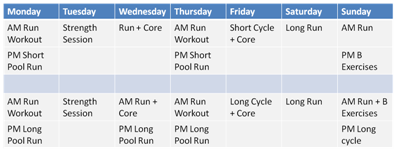How and When Marathoners Should Cross Train
The following is part of the MN Guest Post series, a new program to highlight the other excellent writers in the running space. If you or someone you know has an article to contribute, please email patrick [at] marathonnation [dot] us. Enjoy this great post from Jason!
Runners are creatures of habit. We like to run. Especially marathoners, who often favor higher mileage and skip the “extras” that don’t directly contribute to their marathon-specific fitness.
Those cross-training workouts – like core work, pool running or cycling, and strength exercises – have dramatic benefits for marathoners and shouldn’t be skipped. Knowing when to implement them in a smart training plan can help you recover faster, run more, and ultimately get that new personal best.
Aerobic and Strength Exercises
There are two types of cross-training for marathoners that can be added to your training program: additional aerobic workouts or strength exercises. Both are very beneficial but in different ways.
Aerobic exercise increases your endurance and ultimately allows you to run faster for longer. The best types of aerobic exercise includes pool running, cycling (preferably road, as the injury risk in mountain biking is higher), or the elliptical. These types of cross-training are the most specific to running and will give you the most fitness benefit from your time investment. There’s also a much lower risk of injury since these are all non-impact exercises.
Strength exercises like gym workouts, core work, and body weight exercises help you prevent injury, maintain your form when you’re fatigued, and also increase your running economy. I haven’t had a major running injury in over two years – strength work has played a large part in my success.
When designing a strength routine, it’s best to keep it simple. Stick to compound, multi-joint movements in the gym like dead lifts and squats. Body weight exercises can include push-ups, pistol squats, and bridges. My favorite core exercises are planks, bird dogs, and side planks.
Alternating different types of strength work should enable you to run more without getting hurt. Train more in a smart training plan and you’re going to run a faster marathon.
Scheduling Your Cross-Training
Now that you know some of the best cross-training exercises for runners, how do you fit them in to your training plan? That depends on your goals.
Aerobic cross-training can be added if you think your endurance is lacking or if you’d like some easy recovery from harder running workouts. To add endurance workouts to your schedule, you can cross-train on days you’re not running or doing an easy run. If you run every day, it’s best to split up the running and cross-training workouts as double sessions with your non-running workout in the afternoon.
Cross-training for recovery is a great way to bounce back from hard workouts or long runs. Many marathoners take the day off after a long run or very hard workout. Instead, try cross-training for about a half hour. You’ll loosen up your muscles, increase blood flow, and help your body get ready for its next run.
The length of your cross-training workouts should be about the same as your average running time. You can go slightly shorter or longer depending on your time limits. Since there’s no impact with these types of exercise, the chance of injury is low. Try to keep your heart rate or perceived effort about the same as a typical distance run. Cross-training for recovery should be short – about the same time as your easiest run – and the effort should be easy.
With strength workouts, it’s best to schedule these for after your runs. As the intensity of these workouts increases (like gym sessions), it’s best to do them later in the afternoon after a morning run to allow yourself extra recovery or on days that you don’t run. Shorter, less intense strength workouts (like core work or body weight exercises), can be done directly after your run.
Our Running Plans Now Online at Endurance Nation!UltraDistance | Marathon Plans | Half Marathon Plans | 10k Plans | 5k Plans |
Putting it Together
It sounds confusing, but it’s actually quite simple. Below are two simple marathon templates that use a lot of cross-training workouts. The first is geared toward recovery and the second is focused on gaining endurance. Both follow the principles outlined in this article (B Exercises = body weight exercises):
There are many ways to implement cross-training in a marathon training program. The suggestions here have been used successfully with me and the runners that I coach. As you near your goal marathon, decrease the amount of time you spend cross-training so you’re tapered and fresh.
What works for you? Have you run a marathon PR using cross-training workouts?
Jason Fitzgerald is a running coach, 2:44 marathoner, and the founder of Strength Running. Sign up for free running advice to help you achieve your best.
Photo Credit – jerryonlife








What is the difference between strength sessions and B
exercises?